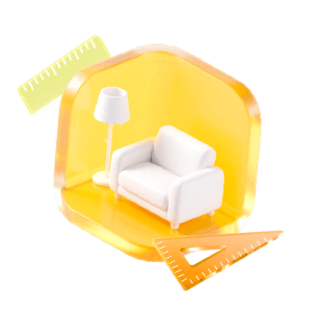
September 23,
Homestyler has updated 3 new customize functions, namely custom ceiling, wall, and floor, which will provide you with a more professional and efficient design experience along with the "tile flooring" and "interior modeling". Below are 5 customize function entrances and introductions.

This tutorial will start with a detailed explanation of the customize ceiling (customize wall and customize floor functions follow the same methodology - draw shapes, extrude, and apply molding or light band).
Tutorial Contents:
1. An introduction to the design interface.
2. How to draw customized ceilings by drawing and extrusion, applying light band and placing lamps?
3. Differences between ceiling models and parametric ceiling.
4. How to design with parametric ceiling to build sloped ceiling, replace materials and further edit with interior modeling?
Detailed operation:
1. An introduction to the design interface.
Please refer to the image below:

2. How to draw customized ceilings by drawing and extrusion, applying light band and placing lamps?
Take the ceiling of the following design as an example:

1)First use "Create Room" tool to draw a room on the canvas, then select "Customize-Customize Ceiling", and click on the room to enter the customize ceiling interface.

2)Select the "Line" tool and click in the room to start drawing. You can input precise values to draw the light strip area, press "Esc" to exit the current command.

After drawing, if you need to adjust the size again, click an edge, enter the corresponding distance value, and press Enter to confirm.

3)Let us continue to the next ceiling area, choose "straight line" or "rectangular" to draw the middle ceiling position.

4)Left click on the middle area and then enter the height of the ceiling in "Extrusion" input box.

5)After setting, click in the bottom left corner to switch to 3D view (shortcut : 3), you will get the following effects:

6)Next, we add the light trough light bar, click "light band-light trough" to add the light trough to a surface(By default, light troughs are added on all four sides. If you need to add a light trough on only one or two sides, press the Ctrl key when adding and choose designated sides.)The method of adding "molding" is the same as that of the light trough.

7)Switch to the 2D view, and click the "Ceiling Appliance" in the left catalog, select the appropriate lamp and add it to the ceiling.

8)After adjusting the position of the lamp, select "Array" and enter the distance and quantity at the top (you can switch between the two values with the Tab key)

9)Finally, enter "Ceiling Electrical Appliances-Electrical Moulds-Air Outlet" to add an air outlet on the side of the ceiling, and adjust the appropriate size in the attribute panel on the right.

3. Differences between ceiling model and parametric ceiling.
Similarities
Both ceiling model and parametric ceiling support one-click import into your room and can automatically match the size of your room to allow efficient ceiling design.
Differences
Parametric Ceiling:
1)You can directly adjust the length, width, and all other parameters of the ceiling, without worrying that the size of the ceiling is too small or too large to cause the ceiling to be out of proportion.

2)The internal structure of "Parametric Ceiling" supports parameter adjustment and setting.

3) Support to be further edited with the "Interior Modeling" function.

4)"Parametric Ceiling" supports adding light troughs, light band and decorative moldings, and adjusting their positions and angles.

5)"Parametric Ceiling" supports material replacement on every surface.

Ceiling models:
1)Provide diversified ceiling models and they can match your room size automatically.

2)The ceiling models support material replacement, but the area that can be replaced depends on the model.

3)The ceiling template supports length, width and height adjustment.

4)Ceiling models support "Add to Fav", which is convenient for next use.

4. How to design with parametric ceiling to build sloped ceiling, replace materials, and further edit with interior modeling?
1)First, select the shape drawing tool at the top to draw the ceiling area in the room.

2)After the ceiling area is drawn and divided, select "Ceiling-Parametric Ceiling" on the left, and you can see 16 different templates in Parametric Ceiling, hover on the information icon to preview the detailed ceiling effect.

3)Choose a suitable template (take Pitched Roof with Beam as an example) and place it in the room. The software will automatically recognize the ceiling area according to the direction of the mouse (the area with blue dots is the ceiling area where you will place it) and click it again. Then the program will automatically match the ceiling with the room.

4)After the parametric ceiling is placed, it will automatically match the size of the room. It is not recommended to adjust the length and width of the ceiling. If you need to adjust, you can adjust it through the anchor point of the selection box. If you need to restore it, click "Auto-Fit".
5)Switch to the 3D view, on the right side you can adjust the parameters of the ceiling template and the size of the internal elements of the ceiling (the Gradient parameter is only supported by the inclined ceiling)

For different parametric ceiling, you could select teh ceiling and then hover on the information icon in the right property panel to view the schematic diagram of the ceiling parameter, which will help you understand the pamammeter settings below.

If you need to do further modeling on the basis of the ceiling template, please select the ceiling and click "Edit Ceiling Model" in the lower right corner to enter the interior modeling function for more editing and adjustments (note: once you enter the interior modeling interface, the parameter template becomes a customized model and can no longer be adjusted with parameter settings)
6)After the ceiling is drawn, left-click to select the ceiling to enter the "Replace Material" interface (you must be in the 3D view or Roam view to display the "Replace Material" function icon)

7)After entering the "Replace Material" interface, you could directly drag appropriate material onto the area you want to apply it to.

8)You can also click "Apply to All" on the right to apply the material to the entire ceiling.

9)After applying the material, click "Finish" to return to the ceiling interface. If you do not need to make other changes, just click "Finish"!




